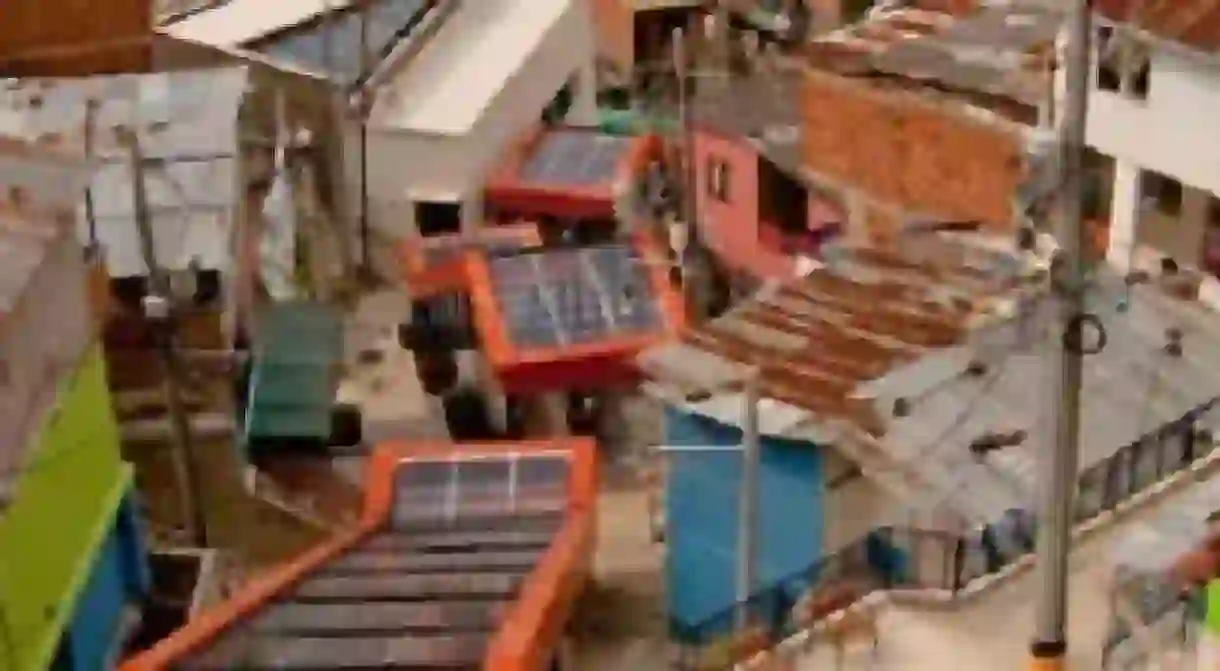From World's Murder Capital to the Medellin Miracle

For Medellín, Pablo Escobar is old news for a good reason. Declared the World’s Most Innovative City by the Urban Land Institute and Wall Street Journal in 2012, Colombia’s second city is credited with one of the most remarkable urban turnarounds in modern history. We take a look at how urban planners, architects, and artists reconquered the poorest neighborhoods, giving back the streets to the people of Medellín.

Working with the remnants of a leftover drug cartel, the city’s leaders began their restructure with the now-famous metro cable car. This transportation structure broke down boundaries and allowed people to connect across all Medellín barrios. Many residents of the city now champion culture over crime, a motto echoed throughout the barrios by independent role models.

A disaster response system has also been a city-wide initiative, ensuring that the people of Medellín have the ability to rebound quickly from problems. The city has built a sense of social urbanism from the ground up. Resilient social infrastructures for all are now in place throughout the city, enabling professional growth and equal access to Medellín’s valuable resources.
The city has established and implemented a participatory budgeting system, where citizens define their priorities and public money is then distributed accordingly. Son Bata, a famous hip-hop group from the Comuna 13 barrio in Medellín, serve as activists against violence. The group has founded a cultural centre within the destitute barrio with money provided by the government. The people of this neighborhood now have access to musical instruments, musical education and potential job placement resources.
SON BATA a TedX Medellin:
In this same barrio, one of the most talked about visual structures added to Medellín’s transformation is the giant escalator. This escalator helps alleviate the stress of stair climbing and reduces the community’s equivalent 26-story ascent from 35 minutes to only six. The structure is also a contemporary beacon amidst ramshackle houses stacked together like mismatched Lego blocks.

España Library may be one of the most famous architectural structures of the new Medellín. This structure, resembling three large black interconnected boulders, is strategically placed at the end of a metro cable car route to barrio Santo Domingo. Designed by famed Bogotán architect Giancarlo Mazzanti, this aesthetic library is not only an educational facility in a barrio once too dangerous for police, but also a civic symbol of hope.

The city’s once off-limits Central Park is now flourishing with new life and hosts the renovated Medellín Botanical Garden. This public space houses orchids, plants and flora native to Colombia. Within the garden sits the Orquideorama, an impressive wooden and steel flower patch standing over 50 feet tall, designed by Plan B Architects.

The 40-acres of surrounding public space is also inviting for water activities, horse riding, and bike riding. Beyond recreational enjoyment, the garden gives people an urban environment with a connection to nature.
Medellín is also known as the home of Fernando Botero, the famous Colombian sculptor often overshadowed by the psychotic stories of Escobar. Botero, with his obtuse style, could affectionately be called the unofficial artist of Colombia. Medellín has paid homage to their prized artist with Plaza Botero, a public space that hosts 23 of Fernando Botero’s bronze sculptures. Most of the sculptures have been rotated and displayed throughout many impressive international art galleries. In the plaza’s adjacent museum, a slew of Botero’s paintings depict a darker time when Medellín was under cartel rule.

Beyond brick and mortar structures or urban spaces, the ‘City of Eternal Spring’ goes through a natural, seasonal transformation as well. With a year-round temperate climate, Medellín is able to produce some of the most brilliant flowers, which are celebrated in a parade every August. Droves of tourists flock to the city for the yearly flower festival called La Fería de las Flores (The Fair of the Flowers). This 10-day cultural festival fills the streets of Medellín with lighthearted people, music, laughter and dancing.

Festivals are not the only reason to dance in this renaissance city. Medellín is famous for rumba, the word Colombians use for party. From tango to salsa to vallenato, Parque Lleras hosts many of Medellín’s trendiest venues. Located in the El Poblado neighborhood, which was built up in the 1990s when Medellín’s elite traded the violence of the city’s centre for the eastern side of the Aburra Valley. El Poblado is the safest and wealthiest neighborhood in Medellín, displaying dog groomers, yoga studios, gourmet grocery stores, and restaurants.
Ajiacos y Mondongos is a culinary standout in Medellín. Located in the El Poblado neighborhood, this restaurant has been rumored to serve the best typical Colombian food in the city since its inception in 1991. Owned and operated by German Ochoa and his daughter Maria Antonia, Ajiacos y Mondogos serves only three menu items: ajiaco soup (a chicken based soup with vegetables), mondongos (tripe soup) and cazuelas (hen soup with vegetables). The meals are made daily from scratch, and the restaurant has been frequented by a gaggle of famous celebrities from fashion mogul Oscar De La Renta to Colombian superstar Juanes.

With every gentrification process comes an influx of recreational activities that lure tourists into the city, followed by hotels to house these said tourists. One of Medellin’s newest and chicest properties is the Art Hotel, located on a quiet street near Parque Lleras. Along with the avant garde movement of Medellín, this 54-room boutique property offers an art gallery and a 40 seat theater within its robust brick walls.
International tourism is a new business for this city, which has has positioned itself and is ready for an influx of visitors. Medellín has made exponential transformations over the past decade, going from one of the most violent cities in the world to an award-winning city. Now an urban area that is recognized worldwide as a role model for cities in other countries, this type of transformation is so rare, it can very easily be classified as a miracle.













